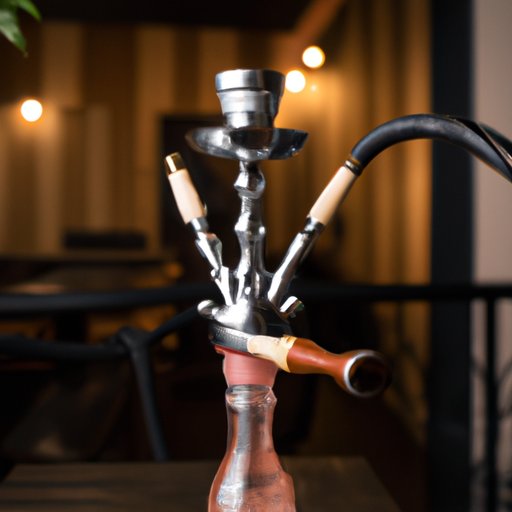Introduction
A hookah is a type of smoking device often used to smoke flavored tobacco or shisha. Hookahs have been used for centuries in many cultures around the world, and the design has evolved over time. In this article, we will explore the different types of hookahs, how they work, and the potential health risks associated with their use.
Definition of a Hookah and its Purpose
A hookah is a water pipe used to smoke flavored tobacco or shisha. The tobacco or shisha is placed in a bowl at the top of the pipe, and then it is heated by charcoal or electric heating elements. This produces smoke that is cooled and filtered through the water in the base of the pipe before it is inhaled. Hookahs are typically used in social settings, and the flavors and aromas of the smoke can add to the atmosphere.
Overview of the Different Types of Hookahs
Hookahs come in a variety of shapes and sizes, from small portable models to larger, more elaborate designs. Traditional hookahs are usually made of brass or copper and feature intricate designs, while modern hookahs are often made of plastic or stainless steel and may include electronic components like LED lights and Bluetooth speakers. Some modern hookahs even have rechargeable batteries.

Summary of the History and Evolution of the Hookah
The origin of the hookah dates back to 16th century India, where tobacco was first smoked through water pipes. Over time, the design of the hookah evolved and spread throughout the Middle East, Africa, and Asia. In recent years, hookah smoking has become popular in the West, and modern hookah technology has advanced significantly.

Exploring the Components of a Hookah and How They Work Together
A typical hookah consists of several components, each of which plays an important role in the smoking process. The main components include the bowl, stem, base, hose, and heat source.
The bowl is the part of the hookah where the tobacco or shisha is placed. The stem connects the bowl to the base, which holds the water that filters and cools the smoke. The hose is attached to the stem and is used to inhale the smoke. The heat source is used to heat the tobacco or shisha, usually in the form of charcoal or electric heating elements.
When the heat source is lit, it heats the tobacco or shisha in the bowl. This produces smoke, which is then drawn down the stem and into the base, where it is cooled and filtered by the water. The smoke then travels up the hose and is inhaled by the user.
A Step-by-Step Guide to Setting Up and Using a Hookah
Setting up and using a hookah is relatively easy, but there are a few steps you need to follow to ensure your safety and get the most out of your experience. Here’s a step-by-step guide to setting up and using a hookah:
- Step 1: Fill the base of the hookah with cold water and make sure all the components are securely connected.
- Step 2: Place the desired amount of tobacco or shisha into the bowl and place the heat source on top of it.
- Step 3: Light the heat source and wait for the tobacco or shisha to start producing smoke.
- Step 4: Place the hose into your mouth and inhale slowly and gently.
- Step 5: Enjoy the flavor and aroma of the smoke and exhale slowly.
It’s important to note that some hookahs require additional setup steps, such as filling the bowl with ice or connecting the hose to an external air pump. Make sure to read the instructions carefully before using any type of hookah.
The Health Effects of Hookah Use
Hookah smoking can be harmful to your health, as it exposes you to many of the same toxins and carcinogens found in cigarettes. The smoke produced by the hookah contains nicotine, tar, carbon monoxide, and other toxic chemicals. Additionally, the charcoal used to heat the tobacco or shisha can produce additional toxins.
If you choose to use a hookah, there are some steps you can take to reduce the health risks. These include using only high-quality tobacco or shisha, avoiding sharing hoses, using clean water in the base, and not smoking for extended periods of time.

A Comparison of Traditional and Modern Hookah Technology
Traditional hookahs are usually made of brass or copper and feature intricate designs. They are powered by charcoal, which must be lit manually and monitored closely to ensure the optimal temperature is maintained. While traditional hookahs offer a unique aesthetic appeal, they can be difficult to use and maintain.
Modern hookahs are often made of plastic or stainless steel and may include electronic components like LED lights and Bluetooth speakers. They are powered by electric heating elements, which can be controlled easily and provide consistent temperatures. Modern hookahs are easier to use and maintain than traditional models, but they lack the same aesthetic appeal.
Conclusion
In this article, we explored the history, components, and uses of hookah technology. We also discussed the potential health risks associated with hookah use and compared traditional and modern hookah technology. Whether you’re a beginner or an experienced hookah smoker, we hope this article has provided you with a better understanding of how hookah works.
We encourage you to explore hookah technology further and experiment with different types of hookahs to find the one that best fits your needs. With the right setup and a bit of practice, you’ll be able to enjoy the rich flavors and aromas of hookah smoking in no time.
(Note: Is this article not meeting your expectations? Do you have knowledge or insights to share? Unlock new opportunities and expand your reach by joining our authors team. Click Registration to join us and share your expertise with our readers.)
